Table of contents
- Wilbers Nivomat damper put to the test The right level
- Spring rate remains a problem
- Function of Wilbers Nivomat damper
- Comfortable, but without teetering
- Wilbers Nivomat with ABE for 799 euros
- When is the level right again??
- The Nivomat damper in detail

jkuenstle.de
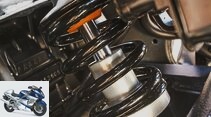
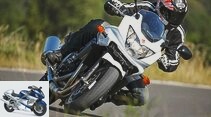
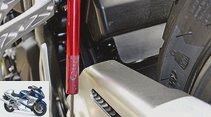
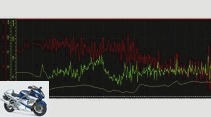
7th pictures
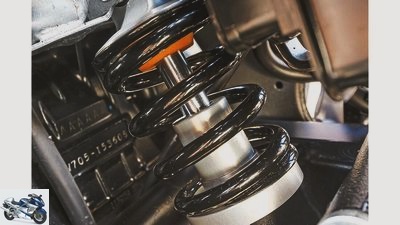
jkuenstle.de
1/7
The suspension spring is short and the piston rod of the Nivomat damper is thick. Compared to conventional struts, it is mounted rotated by 180 degrees.
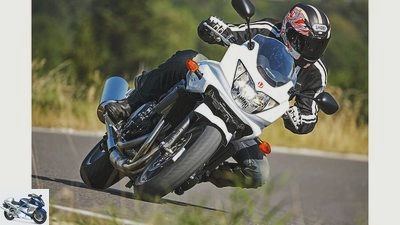
jkuenstle.de
2/7
Nivomat damper test.
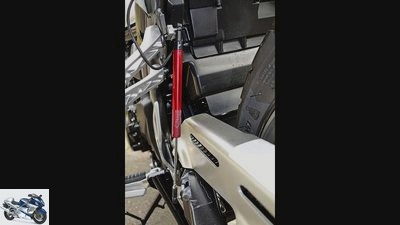
Jens Moller-Tollner
3/7
The stroke of the damper on the test tracks was determined by a spring travel sensor.

Screen
4/7
Rear shock absorber: red; Fork: green; Speed: yellow; Total distance about 400 meters.
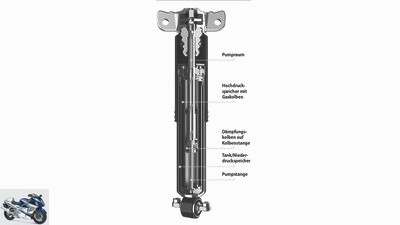
Wilbers
5/7
From top to bottom: pump chamber, high pressure accumulator with gas piston, damping piston on piston rod, tank / low pressure accumulator, pump rod.

jkuenstle.de
6/7
The angle of attack of the swing arm shows that the Wilbers-Bandit’s load does not matter.
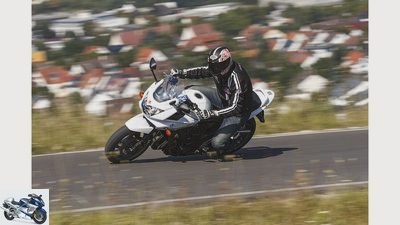
jkuenstle.de
7/7
Picture gallery: Test Nivomat damper.
accesories
landing gear & Spring elements
Nivomat damper test
Wilbers Nivomat damper put to the test
The right level
It’s not a question of character, but of the level of motorcycle chassis. That should always show the ideal ratio of positive to negative suspension travel. The new Nivomat damper from Wilbers regulates this automatically.
Jens Moller-Tollner
10/13/2016
Is there anything more important in a motorcycle than a well-functioning chassis? Hardly likely. You can get used to a rumbling engine, a bad chassis prevents any driving pleasure. An important aspect of the suspension elements is the correct ratio of positive to negative suspension travel. Regardless of whether you are alone or as a couple, the ratio should always be in the range of a third negative and around two thirds positive spring deflection. Negative spring deflection is the portion of the spring deflection that is used up by the weight of the machine and the load. The positive suspension travel is the size that is available as further compression travel.
Buy complete article

Wilbers Nivomat damper put to the test
The right level
4 pages) as PDF
€ 2.00
Buy now
Spring rate remains a problem
Since changes in the payload have a much stronger effect at the rear than at the front, the damper in particular has to be adjusted before starting the journey. In practice this means: changing the preload. Ultimately, the geometry of the vehicle should remain in the ideal state. With the introduction of electronically controlled spring elements, a lot has happened in this area. A click on the handlebar end and the shock absorber changes the preload. “One person”, “one person with a load” or “fully loaded” are the requirements in most cases. It is obvious that this preselection is very rough and therefore not ideal. Components such as the Aprilia Caponord 1200 Rally make things more precise. A sensor measures how far the shock absorber sags when it is loaded and automatically adjusts the preload. That is pretty close to the ideal.
The problem is: only the geometry changes, the spring rate remains the same. Actually, the spring should be harder with more payload. Suspension struts such as the new Nivomat damper from Wilbers demonstrate how this requirement can be met. BMW installed such types in the R 100 RT and the K 100 LT as early as the 1970s and 1980s; in the case of passenger cars, models from Volvo and VW, among others, were equipped with them. Together with ZF Wilbers has now developed a Nivomat damper for motorcycles, which MOTORRAD was able to test in a Suzuki Bandit 1250 S before the start of series production.
Function of Wilbers Nivomat damper
Before we go on the extensive trial round, a few words about the function. The Nivomat has two separate oil chambers and a mechanical pump with a check valve. If his payload increases, his mechanical height regulator is activated and the integrated pump starts to work. This uses the movements that occur while driving as energy. The pump pumps oil from the tank, i.e. from the low-pressure chamber, into the high-pressure chamber (see graphic), which contains a gas piston.
The pressure in this chamber acts directly on the piston rod. It is pushed out of the shock absorber, which returns to its zero position. Since the oil in the high-pressure chamber surrounds the gas piston, the pressure increases progressively and increases with increasing load. The gas volume acts like a spring in the overall damper system, is compressed more and more with a higher load – with up to 120 bar – and with this pressure also brings the piston rod back into the standard position. This area is a few millimeters in which the pump does not work. If the damper continues to rebound, the oil flows from the high-pressure chamber back into the tank via a bypass hole until the zero position is reached. Since, during rebound, the pressure of the high-pressure chamber only acts on the piston rod and no longer on the pump, this movement takes place with less force, which equates to a continuously adapting rebound stage.
In addition to the gas spring, the Wilbers Nivomat has a suspension spring, which is around 30 percent softer than usual due to the progressive spring rate of the gas damper. This promises a sensitive response behavior, which top tester Georg Jelicic is now testing.
Comfortable, but without teetering
The compulsory exercise is called beet field. A little later, the data from the suspension travel sensors mounted on the Suzuki flow into the laptop. And that shows a convincing picture, because with 80 kilograms Georg the dynamic damper spring travel was always in the range of 32 millimeters on average. The Nivomat deflected a maximum of 79 millimeters at the rear. With a total suspension travel of 120 millimeters, that leaves enough air. Despite the reserves, the damper feels its way sensitively along the hard edges of the track, never looking stubborn and overdamped. On the contrary: the Nivomat masters this task with unusual comfort, but without teetering. This does not change even with higher payloads, as the author was able to find out. It’s already ready and puts more weight on the Suzuki. The first measurement while standing – after Georg dismounted – makes this clear. 100 kilograms now press on the shock absorber. That sags further in the state than with Georg. It was 32 millimeters for him, 4.7 centimeters for the author. In order for the pump to work, movement has to come in, so go. While driving, the Nivomat has returned to its zero position after a distance of 270 meters under the additional load. Even with a payload of 100 kilograms, the average dynamic spring deflection is 35 millimeters, and the stop buffer remains unaffected despite the higher load.
A trip for two gives a similar picture. When stationary, the damper sags by 86 millimeters, after a few hundred meters it works again on average in the range of 40 millimeters – with a payload of 180 kilograms. Even the maximum spring travel used is only a little longer than in the case of single trips. They show how progressively the gas spring works. According to Wilbers, it has a spring rate spread of 109 to 160 N / m.
Wilbers Nivomat with ABE for 799 euros
Change of scene: the bumpy track becomes a curved roller coaster. That doesn’t impress the Nivomat. It is only slightly compressed by the centrifugal forces at large inclines, which has a positive effect on the freedom from inclination. The geometry of the Bandit in terms of caster and steering head angle hardly changes, which benefits the driving stability. As a purely mechanical component, the Nivomat has shown the potential of a conventional damper, for which ZF supplies the basic body to Wilbers, who take on the finalization and adaptation to the motorcycle.
From March 2017, the Nivomat damper for the 1250 Bandit will be available from Wilbers including ABE for 799 euros, further types for other motorcycles are already being planned.
When is the level right again??
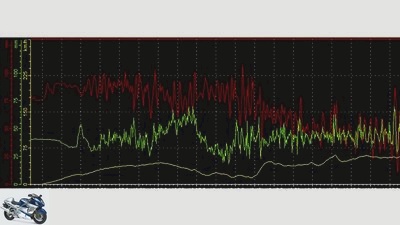
Screen
Rear shock absorber: red; Fork: green; Speed: yellow; Total distance about 400 meters.
The test of the Wilbers Nivomat damper took place on a bumpy and winding route with a payload of up to 180 kilos. How the damper performed under this load on the route with many patches is shown in the diagram using the red line. In the first few meters, the damper compresses up to 105 millimeters.
As the Nivomat works below the zero position, the pump is active. This uses the energy of the up and down strokes to pump oil into the high pressure chamber. The pressure on the piston rod increases and it is pushed out of the damper. After a good 270 meters, the Nivomat works again in the optimal working range.
The Nivomat damper in detail
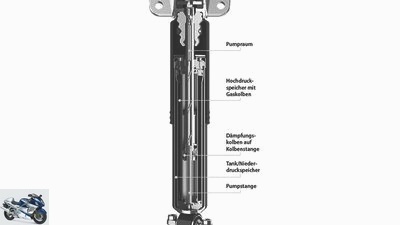
Wilbers
From top to bottom: pump chamber, high pressure accumulator with gas piston, damping piston on piston rod, tank / low pressure accumulator, pump rod.
The Nivomat damper has two oil reservoirs. For a driver who weighs 80 kilograms, the pressure in both is the same, around 60 bar. The damper works in its zero position. If the payload increases, the damper collapses. The integrated altimeter is activated and the pump located in the piston rod sucks in oil from the tank / low-pressure accumulator through the movements of the damper and pumps it into the high-pressure accumulator. It acts directly on the piston rod. This extends because of the higher pressure. The gas, which is separated from oil by a membrane in the high-pressure accumulator, ensures that the pressure increases progressively. This changes the spring rate and compression damping. The Nivomat also adjusts the rebound stage so that the damper does not rebound uncontrollably at high pressures – there are up to 120 bar in the high pressure chamber. During compression, the pump and piston rod act up to 120 bar; during rebound, valves ensure that the pump is not connected to the high pressure area, but to the tank. The pressure is much lower here. The difference between the two accumulators is up to 100 bar. As a result, the Nivomat rebounds in a controlled manner – always according to the pressure ratio between the chambers.
If the level is exceeded – for example, if a passenger steps down – the oil flows via a bypass directly from the high-pressure chamber into the tank. The pressure on the piston rod drops and the damper collapses. A damping piston with a shim package for the rebound and compression stage on the piston rod (as with conventional struts) and a suspension spring complete the structure of the Nivomat damper.
Related articles
-
Test: Aprilia SX 125 Supermoto
motorcycles Test: Aprilia SX 125 Supermoto Test: Aprilia SX 125 Supermoto Cross-beginners She’s cool, sexy, and extremely adult. Aprilia’s new 125cc…
-
Gargolov motorcycles Comparison test: big bikes Comparison test: Big Bikes from Honda and Suzuki Test: Honda CBF 1000 F, CB 1300 S and Suzuki Bandit 1250…
-
Jahn motorcycles Top test Yamaha TDM 900 Top test Yamaha TDM 900 … and third Yamaha’s jack-of-all-trades TDM is already attracting all-round clients in…
-
Comparison test: Honda CBF 1000 Silverline, Suzuki Bandit 1250 S, Yamaha FZ1 Fazer
Jahn 22nd pictures Honda 1/22 Honda CBF 1000 Honda 2/22 Honda CBF 1000 Zdrahal 3/22 Presentation at the fair in Paris. Honda 4/22 Honda CBF 1000 Honda…
-
Comparison test: Honda CBF 600 S and Kawasaki ER-6f
Gargolov motorcycles Comparison test: Honda CBF 600 S and Kawasaki ER-6f Comparison test Honda CBF 600 S and Kawasaki ER-6f They don’t shine in the…
-
Comparison test Ducati Hypermotard old against new
Artist 22nd pictures jkuenstle.de 1/22 Ducati Hypermotard 1100 Evo (old) and Ducati Hypermotard 821 (new). jkuenstle.de 2/22 Ducati Hypermotard 821….
-
Mid-range crossover bikes in a comparison test
www.factstudio.de 32 pictures www.factstudio.de 1/32 Pepped up: The Honda NC 750 X was the only bike in the test field to be revised for this year……
-
Aprilia RSV4 R APRC ABS in the test
Gargolov 35 pictures Gargolov 1/35 The new Aprilia RSV4 R APRC ABS in the test. Gargolov 2/35 The new Aprilia RSV4 R APRC ABS in the test. Gargolov 3/35…
-
Endurance test interim balance for the Suzuki Bandit 1250 S
motorcycles Endurance test interim balance for the Suzuki Bandit 1250 S Endurance test interim balance for the Suzuki Bandit 1250 S The one without…
-
Single test: Kawasaki Ninja 300
Kawasaki motorcycles Single test: Kawasaki Ninja 300 Driving report: Kawasaki Ninja 300 More bite: the new Kawasaki Ninja 300 in the test More…